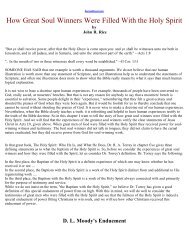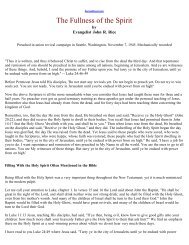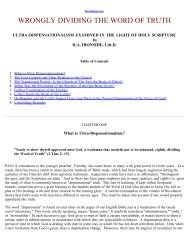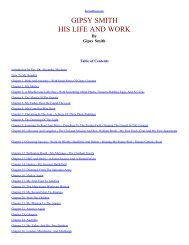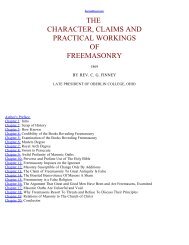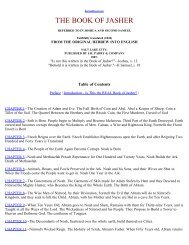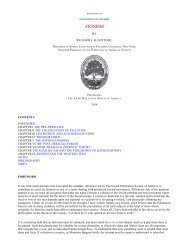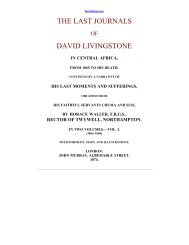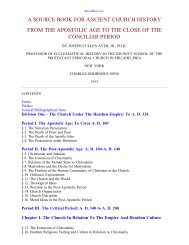Legends of Babylon and Egypt in Relation to Hebrew Tradition.pdf
Legends of Babylon and Egypt in Relation to Hebrew Tradition.pdf
Legends of Babylon and Egypt in Relation to Hebrew Tradition.pdf
You also want an ePaper? Increase the reach of your titles
YUMPU automatically turns print PDFs into web optimized ePapers that Google loves.
was afraid <strong>of</strong> Tiamat, "<strong>and</strong> turned back".[1] The orig<strong>in</strong>al Eridu myth no doubt represented Enki as conquer<strong>in</strong>g the<br />
watery Abyss, which became his home; but there is noth<strong>in</strong>g <strong>to</strong> connect this tradition with his early creative activities.<br />
We have long possessed part <strong>of</strong> another local version <strong>of</strong> the Dragon myth, which describes the conquest <strong>of</strong> a dragon by<br />
some deity other than Marduk; <strong>and</strong> the fight is there described as tak<strong>in</strong>g place, not before Creation, but at a time when<br />
men existed <strong>and</strong> cities had been built.[2] Men <strong>and</strong> gods were equally terrified at the monster's appearance, <strong>and</strong> it was<br />
<strong>to</strong> deliver the l<strong>and</strong> from his clutches that one <strong>of</strong> the gods went out <strong>and</strong> slew him. <strong>Tradition</strong> delighted <strong>to</strong> dwell on the<br />
dragon's enormous size <strong>and</strong> terrible appearance. In this version he is described as fifty /bêru/[3] <strong>in</strong> length <strong>and</strong> one <strong>in</strong><br />
height; his mouth measured six cubits <strong>and</strong> the circuit <strong>of</strong> his ears twelve; he dragged himself along <strong>in</strong> the water, which<br />
he lashed with his tail; <strong>and</strong>, when sla<strong>in</strong>, his blood flowed for three years, three months, a day <strong>and</strong> a night. From this<br />
description we can see he was given the body <strong>of</strong> an enormous serpent.[4]<br />
[1] Tabl. III, l. 53, &c. In the s<strong>to</strong>ry <strong>of</strong> Bel <strong>and</strong> the Dragon, the third <strong>of</strong> the apocryphal additions <strong>to</strong> Daniel, we have<br />
direct evidence <strong>of</strong> the late survival <strong>of</strong> the Dragon /motif/ apart from any trace <strong>of</strong> the Creation myth; <strong>in</strong> this connexion<br />
see Charles, /Apocrypha <strong>and</strong> Pseudopigrapha/, Vol. I (1913), p. 653 f.<br />
[2] See /Seven Tablets/, Vol. I, pp. 116 ff., lxviii f. The text is preserved on an Assyrian tablet made for the library <strong>of</strong><br />
Ashur- bani-pal.<br />
[3] The /bêru/ was the space that could be covered <strong>in</strong> two hours' travell<strong>in</strong>g.<br />
[4] The <strong>Babylon</strong>ian Dragon has progeny <strong>in</strong> the later apocalyptic literature, where we f<strong>in</strong>d very similar descriptions <strong>of</strong><br />
the creatures' size. Among them we may perhaps <strong>in</strong>clude the dragon <strong>in</strong> the Apocalypse <strong>of</strong> Baruch, who, accord<strong>in</strong>g <strong>to</strong><br />
the Slavonic Version, apparently every day dr<strong>in</strong>ks a cubit's depth from the sea, <strong>and</strong> yet the sea does not s<strong>in</strong>k because<br />
<strong>of</strong> the three hundred <strong>and</strong> sixty rivers that flow <strong>in</strong><strong>to</strong> it (cf. James, "Apocrypha Anecdota", Second Series, <strong>in</strong> Armitage<br />
Rob<strong>in</strong>son's /Texts <strong>and</strong> Studies/, V, No. 1, pp. lix ff.). But <strong>Egypt</strong>'s Dragon /motif/ was even more prolific, <strong>and</strong> the /Pistis<br />
Sophia/ undoubtedly suggested descriptions <strong>of</strong> the Serpent, especially <strong>in</strong> connexion with Hades.<br />
A further version <strong>of</strong> the Dragon myth has now been identified on one <strong>of</strong> the tablets recovered dur<strong>in</strong>g the recent<br />
excavations at Ashur,[1] <strong>and</strong> <strong>in</strong> it the dragon is not entirely <strong>of</strong> serpent form, but is a true dragon with legs. Like the<br />
one just described, he is a male monster. The description occurs as part <strong>of</strong> a myth, <strong>of</strong> which the text is so badly<br />
preserved that only the contents <strong>of</strong> one column can be made out with any certa<strong>in</strong>ty. In it a god, whose name is<br />
want<strong>in</strong>g, announces the presence <strong>of</strong> the dragon: "In the water he lies <strong>and</strong> I [. . .]!" Thereupon a second god cries<br />
successively <strong>to</strong> Aruru, the mother- goddess, <strong>and</strong> <strong>to</strong> Pallil, another deity, for help <strong>in</strong> his predicament. And then follows<br />
the description <strong>of</strong> the dragon:<br />
In the sea was the Serpent cre[ated]. Sixty /bêru/ is his length; Thirty /bêru/ high is his he[ad].[2] For half (a /bêru/)<br />
each stretches the surface <strong>of</strong> his ey[es];[3] For twenty /bêru/ go [his feet].[4] He devours fish, the creatures [<strong>of</strong> the sea],<br />
He devours birds, the creatures [<strong>of</strong> the heaven], He devours wild asses, the creatures [<strong>of</strong> the field], He devours men,[5]<br />
<strong>to</strong> the peoples [he . . .].<br />
[1] For the text, see Ebel<strong>in</strong>g, /Assurtexte/ I, No. 6; it is translated by him <strong>in</strong> /Orient. Lit.-Zeit./, Vol. XIX, No. 4 (April,<br />
1916).<br />
[2] The l<strong>in</strong>e reads: /30 bêru ša-ka-a ri-[ša-a-šu]/. Dr. Ebel<strong>in</strong>g renders /ri-ša-a/ as "heads" (Köpfe), imply<strong>in</strong>g that the<br />
dragon had more than one head. It may be po<strong>in</strong>ted out that, if we could accept this translation, we should have an<br />
<strong>in</strong>terest<strong>in</strong>g parallel <strong>to</strong> the description <strong>of</strong> some <strong>of</strong> the primaeval monsters, preserved from Berossus, as {soma men<br />
ekhontas en, kephalas de duo}. But the common word for "head" is /kakkadu/, <strong>and</strong> there can be little doubt that /rîšâ/ is<br />
here used <strong>in</strong> its ord<strong>in</strong>ary sense <strong>of</strong> "head, summit, <strong>to</strong>p" when applied <strong>to</strong> a high build<strong>in</strong>g.<br />
[3] The l<strong>in</strong>e reads: /a-na 1/2 ta-am la-bu-na li-bit ên[a-šu]/. Dr. Ebel<strong>in</strong>g translates, "auf je e<strong>in</strong>e Hälfte ist e<strong>in</strong> Ziegel<br />
[ihrer] Auge[n] gelegt". But /libittu/ is clearly used here, not with its ord<strong>in</strong>ary mean<strong>in</strong>g <strong>of</strong> "brick", which yields a<br />
strange render<strong>in</strong>g, but <strong>in</strong> its special sense, when applied <strong>to</strong> large build<strong>in</strong>gs, <strong>of</strong> "foundation, floor-space, area", i.e.<br />
"surface". Dr. Ebel<strong>in</strong>g reads /ênâ-šu/ at the end <strong>of</strong> the l<strong>in</strong>e, but the sign is broken; perhaps the traces may prove <strong>to</strong> be<br />
those <strong>of</strong> /uznâ šu/, "his ears", <strong>in</strong> which case /li-bit uz[nâ-šu]/ might be rendered either as "surface <strong>of</strong> his ears", or as<br />
"base (lit. foundation) <strong>of</strong> his ears".



